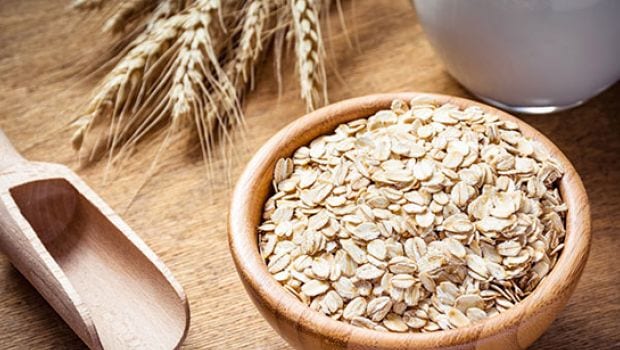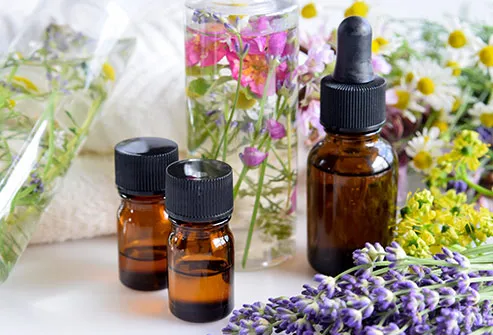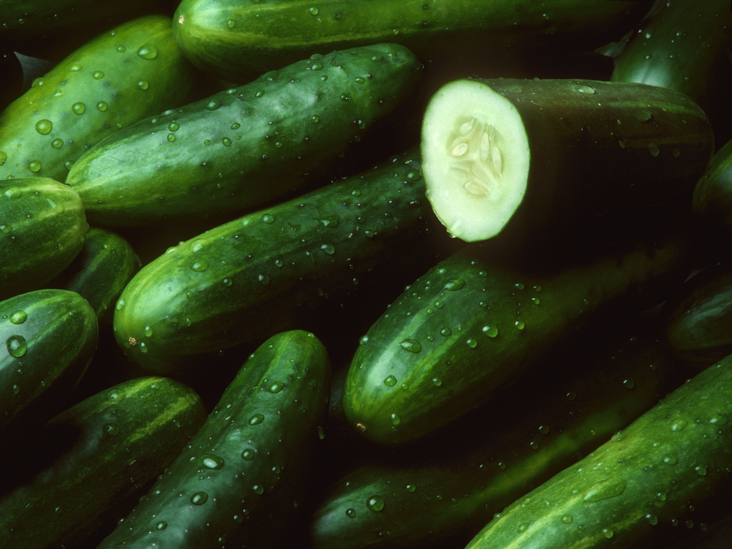12 Home Remedies To Treat Rosacea That Really Work (Video)
by N.Morgan
.jpg)
Rosacea is a common skin condition that causes redness and visible blood vessels in your face. It may also produce small, red, pus-filled bumps. These signs and symptoms may flare up for weeks to months and then go away for a while.
This condition is not only painful but can also cause embarrassment. It begins with flushing and leads to permanent redness, bumps, pimples, broken capillaries and eventually thickening of the skin around the nose. The National Rosacea Society estimates that 69% of sufferers said that their condition made them feel “Frustrated, embarrassed, and negatively affected their self-esteem.”
Symptoms Of Rosacea
You might have rosacea if you experience any of these symptoms frequently:
- Small bumps (not acne) on your cheeks, nose, forehead, and chin
- A red, bulbous nose
- Frequent flushing
- Burning or stinging feeling in your face
- Spider-like blood vessels on the face
- Burning or irritated eyes
Rosacea is more common in females, people with light skin and those of Celtic or Northern European descent. Most people diagnosed with this condition are between 30 and 50 years of age.
Causes & Treatment Of Rosacea
Although the exact cause of rosacea is not quite known, research has discovered several things common to sufferers:
Inflammation
Scientists measured the blood flow in areas where rosacea was occurring and found that inflammation was three to four times greater in these parts than other parts. When the skin flushes, as it does with this condition, it is an inflammatory response similar to what happens when we break a bone. Blood rushes to the area to promote healing. However, the problem is that there is no broken bone or bruised skin to repair. The skin is inflamed with the blood but there is nothing to repair. Because the skin on our face is comprised of a very fragile system of blood vessels, the constant rush of blood can cause damage.

Skin Mites & Bacteria
We all have microscopic organisms on our skin called Demodex mites. These exist near our hair follicles and carry bacteria that can irritate the skin. People who have rosacea have a higher amount of these particular mites.
For people with uncompromised skin, the immune system does a good job of making sure that the mites don’t overpopulate and cause irritation. For those with rosacea, however, there is an overpopulation of mites, too many for the normal immune system to handle. Thus, the skin becomes damaged.
Some people may have been prescribed antibiotics for the condition but research shows that long-term use of antibiotics can be devastating to overall health and wellbeing.
Strained Blood Vessels
The blood vessels in the face are similar to balloons that are inflated and deflated with blood flow passing in and out. As we grow older, the vessels become less rigid and are unable to empty quickly. Flushing, as happens with rosacea causes the vessels to fill and when they don’t empty they stay swollen and eventually cause red spots to pop up under the skin.
Things That Trigger Rosacea
There are a number of triggers that seem to make facial- redness/rosacea worse and avoiding these as much as possible is a good first step. However, if you are like others who suffer, you may have a response to more than one of the common triggers, many of which are things that happen as a result of daily living. This can really make it hard to be in charge of your condition.
Some common triggers according to the National Rosacea Society include:
- Sun exposure
- Wind
- Exercise
- Hot weather
- Stress
- Alcohol consumption
- Spicy foods
- Medications
- Heated beverages
- Humidity
- Cosmetics
Natural Treatments & Home Remedies For Rosacea
Conventional treatments for this condition often include antibiotics or a very expensive and painful therapy that involves scraping off layers of skin. However, neither one of these helps to solve underlying issues.
The good news is that there are some very effective and natural ways to soothe inflamed and red skin. These remedies will help to make this condition much more manageable.
1. Green Tea
According to WebMD, a study conducted by the American Academy of Dermatology found that patients treated with a green tea extract cream had a 70% reduction in symptoms compared with those who received a placebo. To benefit from green tea’s anti-inflammatory properties, chill one cup of green tea in the refrigerator for about thirty minutes.
Soak a clean cotton cloth in the chilled green tea and apply it to the affected area. You can also drink a few cups of organic green tea a day and benefit from its antioxidant properties that help to ease inflammation and fight free radicals.
2. Oatmeal
Oatmeal is known for its ability to calm the skin. Oatmeal contains avenanthramides, which are known to have powerful anti-inflammatory properties. Oatmeal can help not only reduce swelling but also ease itching and irritation. Grind a handful of organic oats in your blender or food processor. Mix ½ cup oats with water and make a paste.
Apply to clean and dry skin and leave on for about twenty minutes. Rinse with cool water and pat dry. Be sure not to scrub your skin, this will cause additional irritation.
3. Essential Oils
There are several essential oils that are well known for their anti-inflammatory, antibacterial and calming properties. Tea tree oil, also known as melaleuca oil, has powerful antiseptic properties and is known as one of the top antibacterial essential oils. This makes it a powerful combatant against skin mites. Lavender essential oil contains anti-inflammatory, antifungal, antiseptic, antibacterial and antimicrobial properties.
To make a soothing essential oil remedy for rosacea, combine one tablespoon of avocado oil with one drop of lavender oil and one drop of tea tree in a roller bottle. Shake and apply to the affected area each night before bed. The oils will go to work while you sleep to ease inflammation and fight bacteria on the skin.
4. Aloe Vera
Aloe is remarkable natural skin hydration that also detoxifies when applied externally. It contains auxin and gibberellins, hormones that help reduce inflammation and redness. Be sure to purchase only pure aloe or use aloe gel from a plant.
If you suffer from mild to moderate rosacea, apply the gel to the affected area twice per day. For those with a more serious condition, four applications daily may be necessary.

5. Apple Cider Vinegar
Drinking one teaspoon of apple cider vinegar combined with a cup of warm water and a teaspoon of raw honey can help balance your pH levels and improve gut bacteria which will ease rosacea symptoms. Apple cider vinegar can also be applied topically to help ease inflammation and redness.
To use, mix 2 tablespoons of organic apple cider vinegar with 8 tablespoons of water. Dip a clean cotton rag in the mixture and apply it to your skin for about ten minutes and rinse with warm water and pat dry. Use this method three times a week and be sure to use only unfiltered, raw apple cider vinegar.
6. Flaxseed Oil
Flaxseed oil, also known as linseed oil, comes from the highly nutritious flaxseed. This oil contains healthy omega-3 fatty acids that have been shown to not only reduce inflammation but also promote healthy brain function, improved mood and encourage healthy skin and hair.
To help reduce overall inflammation in the body, consume 1 teaspoon of cold-pressed, organic flaxseed oil three times per day.
7. Cucumbers
You might be familiar with using raw cucumber slices to reduce eye puffiness. The same method works for rosacea. Applying thin slices of cool cucumbers to your face can help ease swelling and flushing. Cucumber flesh contains water and vitamin C which helps soothe skin and reduce swelling. Cucumbers also contain astringent and nourishing properties.
For a super healing mask, blend one medium cucumber (peeled and cut into pieces) in a blender. Pour the puree through a cheesecloth-lined strainer. Let it strain for about fifteen minutes. Mix the strained cucumber juice with the honey and pour it into a clean bottle. Soak a cotton ball in the mixture and dab on your face in the morning and evening and let it air dry.
8. Chamomile
Chamomile is a calming herb that is often consumed as a tea to help ease insomnia. What you might not know is that this same herb contains essential oils and flavonoids that soothe the skin and promote healing. Additionally, chamomile is a powerful anti-inflammatory with anti-bacterial and anti-allergenic properties.
The best way to benefit from the healing properties of chamomile is to steep a handful of chamomile flowers in three cups of boiling water. Cool the tea in the refrigerator and dip a cotton cloth in the cooled tea and use it as a compress to ease inflammation as needed.
9. Turmeric
According to the National Center for Complementary Medicine (NCCAM), studies show that curcumin, the main component of the Indian spice turmeric, has anti-inflammatory, antioxidant and anti-cancer properties. Additionally, curcumin detoxifies the skin and helps heal damaged skin cells. Studies have shown turmeric has powerful antimicrobial properties that will reduce the growth and multiplication of a number of microbes on facial skin.
Adding turmeric to your diet will help with overall inflammation. Additionally, you can make a turmeric face mask for topical application. Mix a teaspoon of ground turmeric with some organic coconut oil and apply this to your face. Let it sit for about thirty minutes and rinse off with warm water and pat dry. Repeat as often as necessary to reduce inflammation and redness and promote healing.

10. Raw Honey
Honey is truly one of nature’s most powerful healing foods. It is a humectant, which means that it helps your skin retain moisture without making it feel oily. Raw honey, especially manuka honey, is loaded with antiseptic and antibacterial properties. Even conventional medicine uses honey for chronic wound management and on burns to help promote healing and keep infection at bay. To use honey for rosacea, massage a small amount of warm raw honey into clean skin. Let it sit for about ten minutes and wash off with warm water and pat dry.
 11. Diet Changes
11. Diet Changes
According to Dr. Chutkan, MD, a gastroenterologist and assistant professor in the division of gastroenterology at Georgetown University Hospital in Washington, D.C., and author of the book Gutbliss, diet plays a very important role in the management of rosacea. As mentioned earlier, an imbalance of gut bacteria can lead to a worsening of rosacea symptoms.
Chutkan recommends that those suffering from rosacea avoid sugary and starchy foods that contribute to an overgrowth in bacteria in the gut. Instead, she says, eat lots of leafy greens and other high-fiber foods such as asparagus, lentils, and kale. Avoid citrus and spicy foods and eat more fermented foods instead to support healthy bacteria. Also, be sure that you are not drinking sugary beverages and consuming plenty of water daily.

12. Manage Stress
We live in a rush, a rush culture that is fueled by stress. However, chronic stress is dangerous to your health and can contribute to a worsening of rosacea symptoms. Getting a handle on stress will not only help reduce flushing and inflammation in your face but also contribute to better overall health.
A few ways to cope with stress include practicing yoga, listening to calming music, watching funny videos, learning how to breathe deeply, journaling, learning how to say no, aromatherapy, massage, meditation, and prayer. Find what works for you and you will experience better overall health and a decrease in the number of rosacea flare-ups.
Give The Gift Of Health And Support BeforeItsNews By Trying All Our Health Products Below.
We have an affiliate program designed for content creators and affiliate marketers, who would like to sell this product, please click here for affiliate program details. Our affiliate program is designed to help you monetize your screen time.
References:





.png)



Comments
Post a Comment